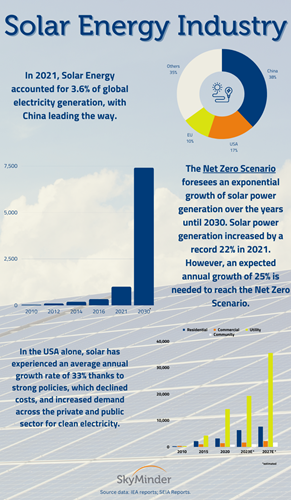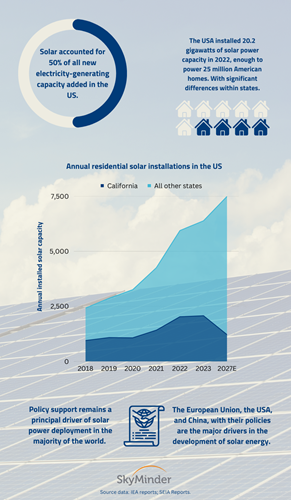Analysis and Studies - Studies
A Market Insight on Solar Power Industry
May 11th 2023
An Insight of the Solar Power Industry
In the last decade, renewable energy sources have become more and more important in every part of the planet. Indeed, with the climate crisis raging and the consequent natural disasters, all the countries are trying to invest in renewable resources, such as wind, hydropower, and solar.
 Solar power accounted for 3.6% of global electricity generation, and it remains the third largest renewable electricity technology behind hydropower and wind energy.
Solar power accounted for 3.6% of global electricity generation, and it remains the third largest renewable electricity technology behind hydropower and wind energy.
China was the major solar power leader with about 38% of solar generation growth in 2021, thanks to large capacity additions, and important state policies, in 2020 and 2021. The second largest generation growth, which account to roughly 17% share of the total was recorded in the United States, and third largest in the European Union with about 10% of generation growth.
Solar generation increased by a record of 22% in 2021 and exceeded 1000 TWh (terawatt hours). It demonstrated the second largest absolute generation growth of all renewable technologies in 2021, after wind. Furthermore, solar energy is becoming the lowest-cost option for new electricity generation in most countries of the world; as a result, it is expected to propel investment in the coming years and to become one of the greatest sources of energy worldwide. However, the Net Zero Emissions 2030 foresees that, in order for it to be fulfilled, there should be an annual growth of the average generation peaking to 25% in the period 2022-2030. This requires a lot of policy ambition and more effort from both public and private stakeholders, especially in the areas of grid integration and the mitigation of policy, regulation and financing challenges. This is even more important in emerging and developing countries.
Moreover, the percentage of solar energy differs from the type of usage. Indeed, utility-scale plants were the major contributors of solar energy, accounting for 52% of global solar capacity in 2021. They were followed by the residential at 28% and commercial/industrial at 19%.
An Insight of the Solar Market in the USA
The U.S. installed more gigawatts of solar capacity in 2022 to reach higher standards, reaching an  important number which is enough to power 25 million American homes. Solar energy, in 2022, accounted for 50% of all new electricity-generating capacity added in the US, whereas solar energy for residential purposes had a record year with most of the new installations which presented a 40% growth over 2021. The other market segments saw downturns in 2022 due to significant supply chain challenges; utility-scale solar in particular fell 31% over the previous year. Despite these challenges, the passage of the Inflation Reduction Act (IRA) has created a significant increase to the long-term solar forecasts. Over the next 10 years, studies argue, the solar industry will grow five times larger than it is today. Indeed, even many US-based important companies, such as Apple, Meta, and Amazon are investing in solar energy.
important number which is enough to power 25 million American homes. Solar energy, in 2022, accounted for 50% of all new electricity-generating capacity added in the US, whereas solar energy for residential purposes had a record year with most of the new installations which presented a 40% growth over 2021. The other market segments saw downturns in 2022 due to significant supply chain challenges; utility-scale solar in particular fell 31% over the previous year. Despite these challenges, the passage of the Inflation Reduction Act (IRA) has created a significant increase to the long-term solar forecasts. Over the next 10 years, studies argue, the solar industry will grow five times larger than it is today. Indeed, even many US-based important companies, such as Apple, Meta, and Amazon are investing in solar energy.
There are of course differences among the different states in the US. For instance, California, famously known for its sunny weather, registered many more household installations of solar energy compared to its counterparts. However, during the last years, the installations seem to hamper in California, which registered an outstanding contraction of nearly 40%, whereas, the other states registered a big increase.
Policy Support in other Countries
Policy support remains a principal driver of solar development in the majority of the world, and especially the so-called “developed” countries. Various types of policy are behind the capacity growth, including auctions, feed-in tariffs, net-metering and contracts for difference. The main drivers for the development of such policies favoring the installations of solar panels for the production of solar energy are mainly, China, the USA, and the European Union countries. Some instances of relevant policy and target changes affecting solar energy growth have been implemented all around the two-year-period of 2021-2022:
- China's 14th Five-Year Plan, which was released in June 2022, set a lofty goal for 33% of electricity generation to come from renewable sources by 2025.
- The Inflation Reduction Act (IRA), a law that greatly increases support for renewable energy in the following ten years through tax credits and other measures, was submitted by the federal government of the United States in August 2022.
- The European Commission suggested raising the 2030 renewable energy target for the union from 32% to 40% in July 2021. The REPowerEU Plan upped the intended objective even more, raising it to 45% in May 2022. Many countries in the EU have already increased the capacity of their solar energy support systems in order to meet the 2030 targets and address the energy crisis brought on by Russia's notorious invasion of Ukraine.
